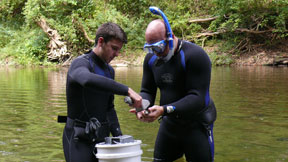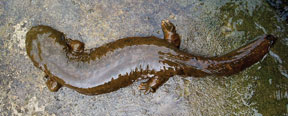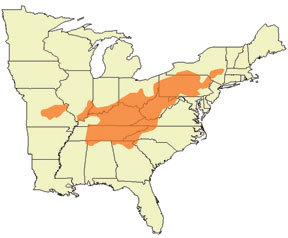Purdue part of national group bent on saving the hellbender
October 10, 2012
 |
|
Rod Williams (right) and
former Purdue undergraduate forestry student Cody Rhoden scan an eastern
hellbender before releasing it into a Southern Indiana river. (Purdue
Agricultural Communication photo/Jamie Loizzo) |
WEST LAFAYETTE, Ind. – Purdue University scientists are part of a nationwide effort to save a declining species of an amphibian called the hellbender, with hopes of rallying people to do the same.
The group is trying to save North America's largest salamander, also known as a "devil dog" and "old lasagna sides." These giant salamanders are typically 11-24 inches long with flat green or brown bodies that have noticeable wrinkles on the sides. They are long-lived and spend up to 30 years under flat rocks in rivers and streams across Appalachia, parts of the Midwest and the northern tips of several southern states.
But the eastern hellbender is endangered in five states and protected or of special concern in many others.
"Their populations are declining in many of their geographic locations," said Rod Williams, a Purdue assistant professor of forestry and natural resources and leader of the university's hellbender efforts. "This species has hardly changed in 160 million years of existence, so we think it's worth the effort to do our part to save this living fossil."
Surveys in Indiana starting in 1998 showed that populations had not only declined, but that the remaining hellbenders were in particular danger. Investigators have found eggs and older adults, but not much in between.
 |
|
An adult eastern hellbender. (Photo courtesy Rod
Williams Laboratory) |
"We're not finding many of them, and the ones we're finding are all adults, which indicates that their population is not doing well," said Katie Smith, wildlife diversity program manager for the Indiana Department of Natural Resources, who has led state efforts to look for Hellbenders.
As part of the effort to increase Indiana hellbender populations, Purdue scientists are relocating the amphibians to areas that have seen decline. The group obtained 18 juvenile hellbenders that were originally collected in West Virginia. The hellbenders spent time in a zoo in Texas and then were reared at Purdue until they reached 4 years old – the point at which they are no longer easy prey for predators. Eight were released in Southern Indiana last month. The others will find new homes in the coming months.
Before the release, a radio transmitter was inserted into each hellbender to allow the scientists to track their movements. That information will help build understanding about habitats that are suitable for hellbenders and their movement in rivers, and track their survival.
 |
|
The eastern hellbender is
currently found across Applachia and parts of the Midwest, as well as small
portions of a few southern states. (Map created by Bart Kraus, Purdue graduate
student) |
"What I hope is that in five years, 10 years - as the Indiana DNR continues to do surveys - that they'll start to see the numbers rebound and they'll see some of those other age classes and natural reproduction that doesn't require us to intervene," said Steve Kimble, a Purdue post-doctoral researcher working with Williams.
The next step is to survey other locations throughout the state to evaluate their suitability for future hellbender reintroductions.
In the laboratory, Williams and Zach Olson, a former post-doctoral researcher at Purdue and current assistant research professor at the University of New England, showed that they could detect a hellbender's DNA from samples of moving water (termed eDNA sampling) in areas the species is thought to live. Their findings were published in the current issue of the journal Wildlife Research.
The method is especially valuable because traditional detection methods required people to literally turn over stones in rivers and visually spot a hellbender. It is time-consuming and dangerous for the surveyors and the hellbenders, which could be injured or killed if a rock slipped or pinched them during lifting.
The eDNA method also speeds research aimed at saving the species.
"We don't have to cover hundreds of meters of water in a day now," Olson said. "We can cover an entire watershed in a day."
Beyond the scientists' efforts, saving hellbenders will take buy-in from people who live in the areas surrounding the rivers and streams where the animals live. Recreational users need to know that if they encounter a hellbender or snag one with a fishing line that the animal needs to be released as quickly and gently as possible – preferably by cutting the line.
Outreach specialists and social scientists are developing publications and programs that will increase awareness about hellbenders and provide tips on how to reverse population decline. The effort includes lesson plans for teachers and information about how homeowners and land managers can help keep local water clean. The group has launched a website - http://www.helpthehellbender.org - to serve as a clearinghouse for information.
"We have to make sure people know what to do if they catch one and make sure that people know they need to keep water clean," said Linda Prokopy, a Purdue associate professor of natural resources planning. "The awareness right now is pretty low, especially among the general population."
Nathan Mullendore, a research associate and outreach coordinator for the project, said fewer than half the people surveyed around hellbender habitats had ever heard of the amphibian, and only half of the those polled had claimed to have ever seen one. Once informed, however, those same people showed interest in helping hellbender populations.
"When you have something that's so special and so unique, I think it gives people an extra reason to care about local environmental quality," Mullendore said. "This is not just about one animal. It's about the ecosystem that supports all of us."
Writer: Brian Wallheimer, 765-496-2050, bwallhei@purdue.edu
Sources: Rod Williams, 765-494-3568, rodw@purdue.edu
Katie Smith, 317-232-8160, kgsmith@dnr.in.gov
Steve Kimble, 205-337-4843, skimble@purdue.edu
Zach Olson, 207-602-2766, zolson@une.edu
Linda Prokopy, 765-496-2221, lprokopy@purdue.edu
Nathan Mullendore, 765-496-3135, nmullend@purdue.edu
ABSTRACT
An eDNA Approach to Detect Eastern Hellbenders (Cryptobranchus a. alleganiensis) Using Samples of Water
Zachary H. Olson, Jeffrey T. Briggler and Rod N. Williams
Context: Environmental DNA, or eDNA, methods are a novel application of non-invasive genetic sampling in which DNA from organisms is detected via sampling of water or soil, typically for the purposes of determining the presence or absence of an organism. eDNA methods have the potential to revolutionise the study of rare or endangered taxa.
Aims: We evaluated the efficacy of eDNA sampling to detect populations of an amphibian of conservation concern, the eastern hellbender (Cryptobranchus a. alleganiensis), indirectly from their aquatic environments.
Methods: We developed species-specific primers, validated their specificity and sensitivity, and assessed the utility of our methods in silico and in laboratory trials. In the field, we collected water samples from three sites with known densities of hellbenders, and from one site where hellbenders do not occur. We filtered water samples, extracted DNA from filters, and assayed the extraction products for hellbender DNA by using polymerase chain reaction (PCR) and gel electrophoresis.
Key results: Our methods detected hellbenders at densities approaching the lowest of reported natural densities. The low- density site (0.16 hellbenders per 100 m2) yielded two positive amplifications, the medium-density site (0.38 hellbenders per 100 m2) yielded eight positive amplifications, and the high-density site (0.88 hellbenders per 100 m2) yielded 10 positive amplifications. The apparent relationship between density and detection was obfuscated when river discharge was considered. There was no amplifications in any negative control.
Conclusion: eDNA methods may represent a cost-effective means by which to establish broad-scale patterns of occupancy for hellbenders.
Implications: eDNA can be considered a valuable tool for detecting many species that are otherwise difficult to study.
Ag Communications: (765) 494-2722;
Keith Robinson, robins89@purdue.edu
Agriculture News Page

